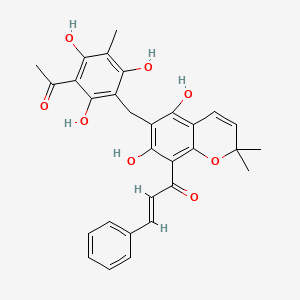| MeSH term | MeSH ID | Detail |
|---|---|---|
| Rhabdomyosarcoma | D012208 | 7 associated lipids |
| Thyroid Neoplasms | D013964 | 33 associated lipids |
| Translocation, Genetic | D014178 | 20 associated lipids |
| Leukemia, Lymphocytic, Chronic, B-Cell | D015451 | 25 associated lipids |
| Leukemia-Lymphoma, Adult T-Cell | D015459 | 25 associated lipids |
| MERRF Syndrome | D017243 | 1 associated lipids |
| Hyperhomocysteinemia | D020138 | 6 associated lipids |
| Atherosclerosis | D050197 | 85 associated lipids |
| Renal Insufficiency, Chronic | D051436 | 9 associated lipids |
rottlerin
Rottlerin is a lipid of Polyketides (PK) class. Rottlerin is associated with abnormalities such as PARAGANGLIOMAS 2, Hyperostosis, Diffuse Idiopathic Skeletal, Virus Diseases, Perisylvian syndrome and Autoimmune disease (systemic) NOS. The involved functions are known as Apoptosis, Regulation, Signal Transduction, inhibitors and Proteasome Inhibitors [MoA]. Rottlerin often locates in Clone, Membrane, Body tissue, Plasma membrane and soluble. The associated genes with Rottlerin are XIAP gene, GAPDH gene, ICAM1 gene, P4HTM gene and TNFSF10 gene. The related lipids are Promega, Fatty Acids, Sphingolipids, Lipopolysaccharides and Saponin. The related experimental models are Mouse Model, Xenograft Model and Cancer Model.
Cross Reference
Introduction
To understand associated biological information of rottlerin, we collected biological information of abnormalities, associated pathways, cellular/molecular locations, biological functions, related genes/proteins, lipids and common seen animal/experimental models with organized paragraphs from literatures.
What diseases are associated with rottlerin?
rottlerin is suspected in Infection, Morphologically altered structure, Ischemia, Pulmonary Edema, Asthma, Cardiovascular Diseases and other diseases in descending order of the highest number of associated sentences.
Related references are mostly published in these journals:
- J. Biol. Chem. (5)
- Am. J. Physiol. Heart Circ. Physiol. (3)
- Am. J. Physiol. Lung Cell Mol. Physiol. (3)
- Others (19)
| Disease | Cross reference | Weighted score | Related literature |
|---|
Possible diseases from mapped MeSH terms on references
We collected disease MeSH terms mapped to the references associated with rottlerin
PubChem Associated disorders and diseases
What pathways are associated with rottlerin
There are no associated biomedical information in the current reference collection.
PubChem Biomolecular Interactions and Pathways
Link to PubChem Biomolecular Interactions and PathwaysWhat cellular locations are associated with rottlerin?
Visualization in cellular structure
Associated locations are in red color. Not associated locations are in black.
Related references are published most in these journals:
| Location | Cross reference | Weighted score | Related literatures |
|---|
What functions are associated with rottlerin?
Related references are published most in these journals:
| Function | Cross reference | Weighted score | Related literatures |
|---|
What lipids are associated with rottlerin?
Related references are published most in these journals:
| Lipid concept | Cross reference | Weighted score | Related literatures |
|---|
What genes are associated with rottlerin?
Related references are published most in these journals:
| Gene | Cross reference | Weighted score | Related literatures |
|---|
What common seen animal models are associated with rottlerin?
Cancer Model
Cancer Model are used in the study 'Rottlerin stimulates apoptosis in pancreatic cancer cells through interactions with proteins of the Bcl-2 family.' (Ohno I et al., 2010) and Cancer Model are used in the study 'Rottlerin induces Wnt co-receptor LRP6 degradation and suppresses both Wnt/β-catenin and mTORC1 signaling in prostate and breast cancer cells.' (Lu W et al., 2014).
Mouse Model
Mouse Model are used in the study 'Neuroprotective effect of protein kinase C delta inhibitor rottlerin in cell culture and animal models of Parkinson's disease.' (Zhang D et al., 2007).
Xenograft Model
Xenograft Model are used in the study 'Rottlerin stimulates apoptosis in pancreatic cancer cells through interactions with proteins of the Bcl-2 family.' (Ohno I et al., 2010).
Related references are published most in these journals:
| Model | Cross reference | Weighted score | Related literatures |
|---|
NCBI Entrez Crosslinks
All references with rottlerin
Download all related citations| Authors | Title | Published | Journal | PubMed Link |
|---|---|---|---|---|
| Hsu HY et al. | Heme oxygenase-1 mediates the anti-inflammatory effect of Curcumin within LPS-stimulated human monocytes. | 2008 | J. Cell. Physiol. | pmid:18357586 |
| Frank DE and Carter WG | Laminin 5 deposition regulates keratinocyte polarization and persistent migration. | 2004 | J. Cell. Sci. | pmid:14996912 |
| Jimenez SA et al. | Role of protein kinase C-delta in the regulation of collagen gene expression in scleroderma fibroblasts. | 2001 | J. Clin. Invest. | pmid:11696585 |
| Sumitomo M et al. | Protein kinase Cdelta amplifies ceramide formation via mitochondrial signaling in prostate cancer cells. | 2002 | J. Clin. Invest. | pmid:11901191 |
| Pabla N et al. | Inhibition of PKCδ reduces cisplatin-induced nephrotoxicity without blocking chemotherapeutic efficacy in mouse models of cancer. | 2011 | J. Clin. Invest. | pmid:21633170 |
| Gäreskog M and Wentzel P | N-Acetylcysteine and alpha-cyano-4-hydroxycinnamic acid alter protein kinase C (PKC)-delta and PKC-zeta and diminish dysmorphogenesis in rat embryos cultured with high glucose in vitro. | 2007 | J. Endocrinol. | pmid:17210758 |
| Shoenfelt JL and Fenton MJ | TLR2- and TLR4-dependent activation of STAT1 serine phosphorylation in murine macrophages is protein kinase C-delta-independent. | 2006 | J. Endotoxin Res. | pmid:16953975 |
| Chen NY et al. | Activation of PKC is required for arsenite-induced signal transduction. | 2000 | J. Environ. Pathol. Toxicol. Oncol. | pmid:10983896 |
| SedmÃková M et al. | Effect of protein kinase C inhibitors on porcine oocyte activation. | 2006 | J. Exp. Zoolog. Part A Comp. Exp. Biol. | pmid:16493646 |
| Rao PE et al. | Differentiation and expansion of T cells with regulatory function from human peripheral lymphocytes by stimulation in the presence of TGF-{beta}. | 2005 | J. Immunol. | pmid:15661903 |
